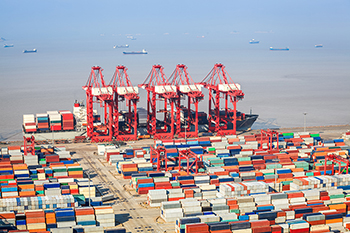
China’s coastal freight rates fall on weak demand


Freight rates for 50,000-60,000t vessels loading coal cargoes at the key transshipment hub of Qinhuangdao port and discharging at Guangzhou port in south China were at 43 yuan/t ($6.20/t)yesterday, according to the Shanghai shipping exchange (SSE). The rate was the lowest since 7 August.
Rates for 40,000-50,000t vessels operating on the Qinhuangdao-Shanghai route were at Yn31.30/t yesterday, the SSE said. This was unchanged from 19 November and the lowest since 6 August.
Most coastal utilities in China have already built up inventories earlier than last year, ahead of the peak winter demand season. Combined stocks at coastal utilities reached 17.62mn t on 20 November, the highest since 1 March 2013 and sufficient for 33 days use.
Coal consumption at coastal utilities has fallen, partly because of the country's policy of shifting coal-fired power generation to China's coal-rich north and west regions. Average daily coal consumption at coastal utilities dropped by 4pc from a year earlier to 767,000 t/d in August. Coal use in September and October registered greater falls of 10pc and 20pc respectively against a year earlier to 638,000 t/d and 516,000 t/d. Coal consumption averaged 514,000 t/d during 1-21 November, down by 12pc from the same period last year.
Utility restocking of domestic material could potentially rebound, if firmer winter demand sets in at a time when authorities have imposed stricter import restrictions. This could potentially support coastal freight rates. The Chinese government has ordered coastal utilities to report each cargo they intend to import during the rest of this year, as annual import quotas are running out quickly. Several utilities have even been asked not to take any more imported cargoes before the lunar new year holiday in early February.
Firmer winter demand has already begun for power plants in north China. Coal consumption at coastal utilities, mostly in east and south China, rose by 3pc from a week earlier to an average of 534,000 t/d in the week to 21 November.


Gold price eases after Trump downplays clash with Fed chair Powell

Copper price hits new record as tariff deadline looms

Chile’s 2025 vote puts mining sector’s future on the line

Brazil producers look to halt pig iron output as US tariff threat crimps demand

Gold price could hit $4,000 by year-end, says Fidelity

Three workers rescued after 60 hours trapped in Canada mine

US targets mine waste to boost local critical minerals supply

Glencore workers brace for layoffs on looming Mount Isa shutdown

Column: EU’s pledge for $250 billion of US energy imports is delusional

Trump tariff surprise triggers implosion of massive copper trade

Maxus expands land holdings at Quarry antimony project in British Columbia

BHP, Vale accused of ‘cheating’ UK law firm out of $1.7 billion in fees

Southern Copper eyes $10.2B Mexico investment pending talks

American Tungsten gets site remediation plan approved for Ima mine in Idaho

Kinross divests entire 12% stake in Yukon-focused White Gold

Gold price could hit $4,000 by year-end, says Fidelity

Southern Copper expects turmoil from US-China trade war to hit copper

Ramaco Resources secures five year permit for Brook rare earth mine in Wyoming

Column: EU’s pledge for $250 billion of US energy imports is delusional

Trump tariff surprise triggers implosion of massive copper trade

Maxus expands land holdings at Quarry antimony project in British Columbia

BHP, Vale accused of ‘cheating’ UK law firm out of $1.7 billion in fees

Southern Copper eyes $10.2B Mexico investment pending talks

American Tungsten gets site remediation plan approved for Ima mine in Idaho

Kinross divests entire 12% stake in Yukon-focused White Gold

Gold price could hit $4,000 by year-end, says Fidelity

Southern Copper expects turmoil from US-China trade war to hit copper

Ramaco Resources secures five year permit for Brook rare earth mine in Wyoming














